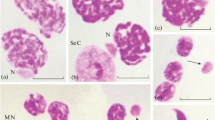Summary
The low dose of 0.2 mg/kg TEM allows the production of viable zygotes from the most sensitive stage of spermatogenesis. The frequency of translocations among offspring conceived during this peak period of sterility at 10–14 days p.i. is greater than among those conceived earlier, so that as the fertility of the treated males decreases (i.e. the percentage of dominant lethals increases) the frequency of translocations among their offspring increases. The results provide presumptive evidence that the spermatids are more sensitive to the mutagenic action of TEM than are the mature spermatozoa. A comparison of the incidence of translocations induced by TEM with that induced by X-rays is made and the significance of the occurrence of sterile animals among the F1 is discussed.
Similar content being viewed by others
References
Auerbach, C., andB. M. Slyzinski: Sensitivity of the Mouse Testis to the mutagenic Action of X-rays. Nature (Lond.)177, 376 (1956).
Bock, M., andH. Jackson: The Action of Triethylenemelamine on the Fertility of Male Rats. Brit. J. Pharmacol.12, 6 (1957).
Cattanach, B. M.: Induction of Translocations in Mice by Triethylene Melamine. Nature (Lond.)180, 1364 (1957).
Cattanach, B. M., andR. G. Edwards: The Effects of Triethyl, enemelamine on the Fertility of Male Mice. Proc. roy. Soc. Edinb. Vol.LXVII, 54–64 (1958).
Craig, A. W., B. W. Fox andH. Jackson: Sensitivity of the Spermatogenic Process in the Rat to Radiominetic Drugs and X-rays. Nature (Lond.)181, 353 (1958).
Falconer, D. S., B. M. Slyzinski andC. Auerbach: Genetical Effects of Nitrogen Mustard in the House Mouse. J. Genet.51, 81 (1952).
Hertwig, P.: Unterschiede in der Entwicklungsfähigkeit von F1 Mäusen nach Röntgen-Bestrahlung von Spermatogonien, fertigen und unfertigen Spermatozoen. Biol. Zbl.58, 273 (1938).
Jackson, H., andM. Bock: Effects of Triethylenemelamine on the Fertility of Rats. Nature (Lond.)175, 1037 (1955).
Russell, W. L.: Genetic Effects of Radiation in Mammals. Radiation Biology, 1 Chapt. 12, edited byA. Hollaender: New York: McGraw-Hill Comp. 1954.
Russell, W. L., L. B. Russell andA. W. Kimball: The Relative Effectiveness of Neutrons from a Nuclear Detonation and from a Cyclotron in inducing Dominant Lethals in the Mouse. Amer. Naturalist89, 269 (1954).
Slizinska, H.: Cytological Analysis of Formaldehyde Induced Chromosomal Changes in “Drosophila melanogaster”. Proc. Roy. Soc. Edin. Vol.LXVI, 288–304 (1954).
Author information
Authors and Affiliations
Rights and permissions
About this article
Cite this article
Cattanach, B.M. The sensitivity of the mouse testis to the mutagenic action of triethylenemelamine. Zeitschrift für Vererbungslehre 90, 1–6 (1959). https://doi.org/10.1007/BF00888569
Received:
Issue Date:
DOI: https://doi.org/10.1007/BF00888569




